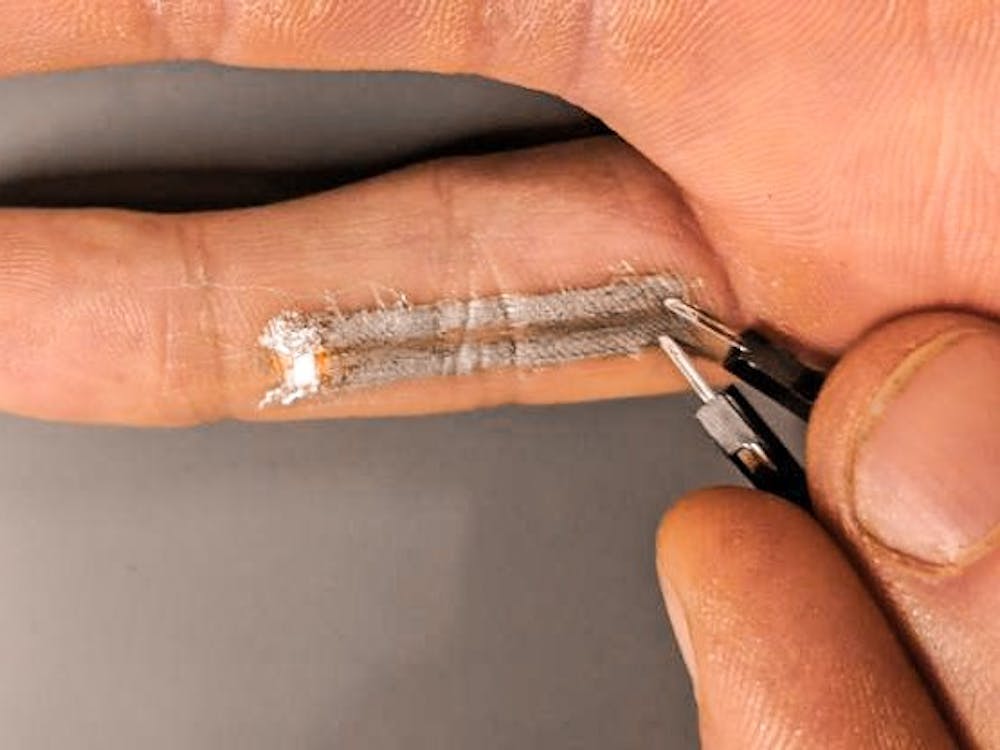Electronic tattoos made from biosensors can be put on your skin without harm, thanks to a professor at the Pratt School of Engineering.
Aaron Franklin, the James L. and Elizabeth M. Vincent associate professor in electrical and computer engineering, and associate professor of chemistry Benjamin Wiley have created a new prototype of biosensor which will enable doctors to gather a much fuller scope of a patient’s health. These biosensors have a particular use for cancer research, as they can detect the potential for new cell formation and the efficacy of chemotherapy measures.
“Rather than transferring electronic substrates to the desired surface, whether it be skin or perhaps a bandage, our technology allows for printing the electronics and sensors directly onto the substrate of interest, which means much easier customization to suit the specific needs of a patient,” he said.
John Rogers, Louis Simpson and Kimberly Querrey professor of materials science and engineering at Northwestern University, originally conceived the idea for the “tattoos,” but Franklin noted that his research team’s tattoo differs in the “mode of fabrication” and “area of application.”
Other applications of the electronic tattoos include the monitoring of sodium levels during transfusion and the overall well-being of those with illnesses like diabetes that reflect a lack of bodily homeostasis. A biosensor is like the proverbial canary in the cage - if it begins to malfunction, doctors can quickly react and identify the issue.
The key to these tattoos’ safety is the fact that nanotechnology, composed of elements “that have very distinct properties because of their nanoscale size,” do not require heat, Franklin said. After printing onto the body, the nanowires gel after a few minutes and become strictly adhesive.
In addition, the durability of this technology allows one patch to retain its conductivity after even a thousand trials.
“Our focus is first on establishing viable inks and printing processes using the most favorable materials, in terms of known cytotoxicity, and then pursue considerations of potential hazards prior to any direct printing onto humans,” Franklin said.
As the advancement of this sort of nanotechnology proliferates, Franklin predicts that it will contribute to the “democratization of quality healthcare,” especially in low-income communities, as it is relatively inexpensive to reproduce and manufacture.
Since nanotechnology is printed simultaneously to the diagnosis, future banadages could fit the patients’ proportions exactly, and the electrical component of biosensors would enable doctors to track a patient’s vital signs even when not at the hospital.
“As we continue to develop these inks, printing processes, and specific biosensors their applicability to human health will hopefully improve, providing access to better point-of-care diagnostics and monitoring techniques for patients,” Franklin said.
Although Franklin’s research is just in the initial stages, he is optimistic about the future of biosensors and nanotechnology but is fully aware of the limiting factors to immediate expansion.
“There remain many challenges to be addressed in order to ensure all needed inks are fully biocompatible and able to yield the desired, complex electronic function when printed directly onto skin or even onto textiles or paper,” he said. “We are a number of years away from solving the remaining technology hurdles and ensuring needed, consistent operation, but it is exciting to be on the path!”
Get The Chronicle straight to your inbox
Signup for our weekly newsletter. Cancel at any time.

